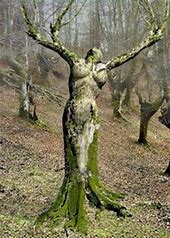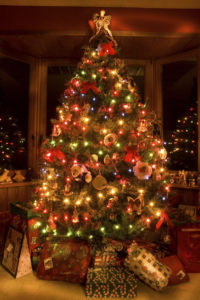Round and Round the Asherah Pole We Go–Parashah 138
This Week’s Torah Reading
This week’s Torah Reading, Parashah 138, is contained in Deuteronomy 16:13-22. My ruach eye (that is, my spirit eye) seemed focused primarily on Deuteronomy 16:21-22. These two verses has to do with, yet again, another admonishment to avoid Canaanite worship and paganism.
Because the passage is so small, I’ll record it here for you. And it reads:
21 Thou shalt not plant thee a grove of any trees near unto the altar of the LORD thy God, which thou shalt make thee. 22 Neither shalt thou set thee up any image; which the LORD thy God hateth. (Deu 16:21-22 KJV)
Not As Easy a Passage to Understand as Some Might Think
Now, prior to my examining these two verses this week, I thought they were quite easy to understand. For the Authorized English Versions of this passage lead us to easily conclude that Father was prohibiting us from retaining and erecting objects of worship in the Land. And surely this line of thinking is contextually reasonable.
However, I was led to break the passage down into its Hebraic and historical parts. And I was led to do so because something was just not setting well with me about this passage.
We Are to Destroy Pagan Objects of Worship in the Land
Yes, Abba repeats Himself throughout Deuteronomy that we are not to adopt Canaanite worship practice. As well as Father also commanded us to utterly destroy all Canaanite sacred places and objects of worship upon our conquest of the Land.
Exo 34:13 But ye shall destroy their altars, break their images, and cut down their groves:
Deu 7:5 But thus shall ye deal with them; ye shall destroy their altars, and break down their images, and cut down their groves, and burn their graven images with fire.
Two Central Elements to our Focus Passage
However, there are two elements to these mitzvot that are of specific concern to Yehovah our Elohim:
1. The planting of a grove of trees near the altar of YHVH.
2. The setting up of any [abominable] images.
Now, most every English translation I consulted in my studies this week failed to convey the fullness of Yehovah’s concerns surrounding this mitzvot. More specifically, the reader of most English Translations of this passage are left with more questions than answers regarding Father’s specific concerns here.
Unfortunately, the average readers of English Bible translations are led to conflate grove of trees and images in these passage. But the fact of the matter is that Abba was expressing two specific concerns here in these mitzvot. But when we break down the language of the text, we learn that Abba is prohibiting His people from engaging in two very sinister things.
A Breakdown of our Focus Passage
Let’s look at each of these two elements more closely and see if we can better understanding Father’s mind.
The planting of a grove of trees in verse 21 breaks down as follows:
1. Plant in Hebrew is “nata’” {naw-tah}, which, depending on how it is used (that is, depending on context), means either to plant; fasten; fix; or establish.
2. Grove in Hebrew is “’asherah”, which is specific for the Canaanite goddess who was known by that name.
3. Trees in Hebrew is “’ets” {ates}, which depending on how it is used, means either plant; wood; or timber.
The setting up of any abominable images in verse 22 breaks down as follows:
1. “Set thee up” in Hebrew is “quwm” {koom}, which means, depending on how it is used either to rise; arise; to stand up; or to rise up.
2. Image in Hebrew is “matstsebah” {mats-tsay-baw}, which depending on how it is used, may mean pillar; a mastaba, which is an Egyptian tomb or monument known as a house of eternity; or stump.
What Was Father’s Main Concerns Related to our Focus Passage?
So now that we have these two elements somewhat broken down into easier bite-size pieces to understanding, what is the concern Father had that led Him to put forth these prohibitions?
Abba had an obvious aversion to the worship of Asherah. What do we know about Asherah?
Who Was and Is Asherah
Asherah was a Mesopotamian, and more pertinent to our discussion, a Canaanite god or goddess. She or it is believed to have been worshiped and respected as the consort of the Sumerian god Anu and the Urgaritic god El, and the Canaanite god Ba’al. In many respects, this goddess seems to be one and the same entity known as the “Queen of Heaven,” aka Semiramus of Nimrod and Tammuz fame (Jeremiah 7:16-18; 44:17-19). I contend that Asherah was and still is a real spiritual entity that stands in opposition to Yehovah and His elect.
Sorting Out Asherah Poles and Groves
These groves were trees the Canaanites planted erected by the Canaanites for purposes of lending tribute and reverence to Asherah. She or it was mate or consort to El, the supposed Creator of the Universe. Asherah is said to have been the mother of several demigods from the Canaanite pantheon. Some 70-demigods are said to have been birthed by Asherah.
This being the case, it should be mentioned that in certain Gnostic beliefs and writings, Asherah has also been tied to Eve as “the mother of all living” (Gen. 3:20).
The whole issue or connection to the worship of Asherah and trees has been forcefully tied, by the spiritually corrupted, to the biblical mention of the Tree of Life (reference Gen. 2:9; 3:22-24).
First Mention of Asherah Poles in Scripture
First mention of the Asherah pole is found in Exodus 34:13. Then later we are instructed to not plant and to destroy Asherah poles or “groves” in Deuteronomy (7:5).
The trees or plants customarily used in Asherah worship included: grapevines; pomegranates; walnuts; myrtles; and willows. These groves were typically planted on scenic hilltops for purposes of providing pagan worshipers a serene environment and place to worship Asherah. Some groves were strategically planted along well-traveled paths and they were serve as resting places for weary travelers.
Asherah as Idols
When Asherah is mentioned in the plural, it generally pertains to cult objects related to the worship of the fertility goddess Asherah. In short, we’re talking about idols of some sort.
But as it relates to groves and groves consisting of trees and being representative of the goddess Asherah, it appears that back in the day, the Canaanites took trees and fashioned them into female forms. These stylized trees were apparently seductive and designed to elicit base desires within the worshiper; in particular with male worshipers. This all makes sense, of course, since Asherah was perceived and worshiped as The central fertility god of the Canaanite pantheon.
Part Two of our Reading
The second part to this mitzvot involved a prohibition against establishment or setting up of pillars or monuments for the purposes of pagan god worship (vs. 22). Such monuments as it relates to this passage, may or may not be specific to Asherah worship. More than likely, Abba was conveying to us that any pagan monuments or structures such as pillars were not to be established or erected. In fact, the groves were to be cut down and the pillars dashed into pieces (Exo. 34:13; Deu. 7:5).
Israel Was Deaf and Blind to these Mitzvot
Unfortunately, these mitzvot fell on deaf Hebrew ears. For we see several examples where Yisra’el fell into Asherah and Ba’al worship in the following passages:
1 Kings 14:15; 16:33
2 Kings 17:16; 21:3;
2 Chronicles. 33:3
Isaiah 17:8
We know from the Cepher of Ezekiel that Asherah worship got so bad in ancient Yisra’el that the nation incorporated (or syncetized) it into their worship of Yehovah and in the Yerushalayim Temple rituals (Jer. 7:18; 44:17-25). The Prophet Ezekiel recorded that such spiritual syncretism led to Yehovah’ s Ruach (His Spirit) departing from the Temple in Yerushalayim (chapters 1-11) and ultimately Judah going into Babylonian captivity.
Our General Ignorance of Asherah Has Led to Spiritual Traps
A great amount of information regarding Asherah, Asherah Poles and Groves and such can be found on various mediums and platforms. A number of books have also been written on the subject. Despite this glut of information related to Asherah worship, at the end of the day, what is truly understood about this entity and the various local and regional worship practices surrounding her or it, is sorely lacking.
And the general thought that often follows this disappointment in our lack of understanding regarding Asherah worship is typically tempered or explained away with the excuse that all of what was known about her (or it) has been lost over the centuries. And that for the most part is true. But the broader and more poignant or relevant thing that we must bear in mind when we run across passages in the Tanakh regarding Ba’al and Asherah is that that which was known and practiced regarding her goddess-ship, if you will, has not disappeared per se.
Asherah Worship has Morphed Over the Centuries
I submit that Asherah and Ba’al worship over the centuries has simply morphed into things, practices and ideologies that many of us today take for granted. Our 21st-century sensibilities and lack of true spirituality and understanding of the things of Yah have led to an inability to identify that which is associated with Asherah and Ba’al. Many times, these elements of worship and paganality exist right under our noses and we’ve simply grown to be blind or deaf to them.
Present Day Asherah Worship Trappings
Many people of supposed Faith own and keep, for instance, buddhas and other religious and symbolic trinkets in their homes. How about the crosses so-called Christians wear religiously around their necks. What about the dubious people and religious practices that we tie ourselves to, despite our profession of Faith in Messiah. These and so many others have links to Asherah and Ba’al worship.
Today, the closest thing here in the west that we could describe as an Asherah pole is what is commonly known as a stripper or dance pole. The stripper or dance pole is an affixed pole (attached to both ceiling and floor of a room) that is used by some women to perform erotic dances. So instead of the graven image of a woman that is made from a tree or even a small female statue of a pagan god, we have in a stripper pole a live woman erotically dancing from it. Thus we have the modern day worship of the female form that is tied to a modern day manifestation of an Asherah Pole. (Ecc. 1:9).
Christmas Trees, adorned with all the common decorations—balls and garland—have been described by some as a manifestation of an Asherah Pole. Aspirants unwittingly bow down to their Christmas Trees as part of their Christmas celebrations (Jer. 10:1-10). This is an abomination that has been brought in to most westerners’ homes, along with wreaths that represent, yet again, female reproductive organs.
Staying Dialed in to Yah’s Word and His Spirit
That’s why it is extremely important that we, as a Faith Community, stayed dialed into the Word of Truth and the workings of the Ruach HaKodesh in our lives. The wisdom in doing this is so that we may be in a position to not only hold ourselves accountable on such things, but also to hold one another accountable.
Unfortunately, of late, there appears to be a resurgence of interest in Asherah worship. It appears that worshiping Yehovah does not hold the personal interests of most people today. And for whatever reason or reasons, many have abandoned Faith in Yehovah and have rejected His Way of life for themselves and their families. These have instead sought after the ways of the Canaanites. These have inserted Asherah and Ba’al worship into their lives either wittingly or unwittingly.
What Does All This Mean to us Today?
So, what does this say to us today as Yah’s elect?
Quite simply this: Although we no longer worship Yehovah via precise rituals as our ancient cousins did, we are still required to worship Him. Today we worship Yehovah in Spirit and in Truth (Joh. 4:23-24). We are no longer under the Levitical Priestly system of worship. Instead, we are now under the Melchizedekian Priesthood, our High Priest being Y’shua HaMashiyach (Heb. 5:6-10; 6:20; 7:10-21).
In our worshiping Abba in Spirit and in Truth, our bodies have replaced the physical Tabernacle or Temple of Yehovah that once stood in Shiloh and then Yerushalayim (1 Cor 6:19). That being said, we cannot permit any semblance of Babylonian, paganistic worship to have a presence in our day-to-day walk with Mashiyach. And we’re not talking only about outright worship of pagan gods such as Bhuddah or Allah. Anything that is not of Yehovah in our lives must not, in any way, draw our attention from the Eternal: be they material things, friends/family, relationships, jobs/careers or personal interests. Yah must be the sole focus of our lives and worship. He is to be our top priority in life. To compromise our Yeshua-focused Torah-based life with things that are not of YHVH will certainly offend Father and ultimately compromise our covenant relationship with Him.
So my friend: have you cut down and utterly destroyed the Asherah Poles and groves in your life?
From Flood to Faith: The Enduring Promise of the Noahic Covenant — Thoughts and Reflections on Torah Reading 7
The Noahic Covenant: Humanity's Path to Redemption Greetings, saints of the Most High. Welcome to another installment of the Messianic Torah Observer. I'm Rod Thomas, coming to you on a beautiful Shabbat in the DFW area. I hope this message finds you and your loved...
Why Aren’t We Keeping the Feast of Rosh Chodesh-Thoughts and Reflections on the Torah Reading for the 9th Rosh Chodesh
Greetings, Saints of the Most High! Welcome to another installment of the Messianic Torah Observer. I'm Rod Thomas, coming to you on a crisp fall afternoon in DFW. Thank you for taking the time to fellowship with me. I hope this post finds you and your loved ones well...
And God Remembered Noah — Thoughts & Reflections on Torah Reading 6 — Reboot
And God Remembered Noah This week's Torah reading, "And God Remembered Noah," is from Genesis 8:1-14, the 6th Parashah in our 3-Year Torah Reading Cycle. The Power of the Ruach In Genesis 8:1, Elohim remembered Noah and sent a wind (ruach) over...
Pleasing God-Yah in Perilous Times-Lessons From the Life of Noah-Thoughts & Reflections on Torah Reading 5 (Reboot)
Torah Reading this week is found in Genesis 6:9-7:24. It is a very familiar passage of Torah that bears a good many themes, concepts and spiritual applications. But for us today, I want us to focus on just one central theme, if you will. And that theme has to do...
Marring the Image of the Creator Yehovah Through Rebelliousness-Thoughts and Reflections on Torah Reading 4
Greeting and Introduction Greetings saints of the Most High and welcome back to another installment of the Messianic Torah Observer. I'm Rod Thomas coming to you on a beautiful fall Shabbat in the DFW. Thank you for taking the time out of your busy schedules to...
Was Eve the First Messianic and the Heart of True Worship — Thoughts & Reflections on Torah Reading 3
Greetings Saints of the Most High. I pray that you, your families, and fellowships are well and blessed. It was my intention to do, at the very least, an audio version of this teaching and discussion. However, since our return from our Kenyan missionary...
My Thoughts and Reflections on Whether Messianics/Netsarim Should Take Part in the Upcoming Electoral Process
Greetings Greetings saints of the Most High. I'm Rod Thomas coming to you from the DFW on a rather stormy first day of the week. Thank you for taking the time out of your busy schedules to fellowship with me and as always beloved, it is my hope, trust, and prayer that...
TMTO Update and Thoughts and Reflections on Kenya Missionary-Sukkot Trip
As I am posting these thoughts and reflections, it is the very last Sabbath of the 7th Biblical Month, November 2, 2024. And assuming our contacts in Israel are successful in sighting the renewed moon the evening of this post, we will enter the 8th Month of Yah's...
When Torah Becomes a Witness Against Us — My Thoughts and Reflections on Torah Reading 148
These are my thoughts and reflections on Torah Reading 148. I’ve been led to entitle this discussion: When Torah Becomes a Witness Against Us.” Our reading this week is found in Deuteronomy/Devarim 31.14-30. Key Themes and Concepts Found in our Parashah this...
Be Strong and Courageous — My Thoughts and Reflections on Torah Reading 147
Greetings saints of the Most High. Thank you for taking the time out of your busy schedules to fellowship with me here on this blessed day of rest in Yeshua Messiah. And as always, it is my hope, trust, and prayer that this installment of the Messianic Torah Observer...



